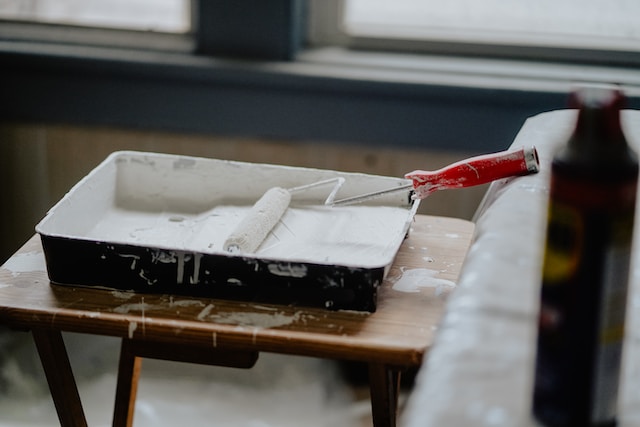Enhance Your Omaha Home's Value with These Pro Painting Tips

When selling your home in Omaha, it's important to consider making minor improvements to increase its appeal and market value. One highly effective and budget-friendly improvement is applying a fresh coat of paint. This goes beyond simply hiding old colors or stains. It involves carefully selecting the right shades, techniques, and finishes to bring each room to life.
Before searching for local painters, consider these expert painting tips to make sure your property leaves a lasting impression:
1. The Power Of Neutral Tones
Neutral colors such as beige, gray, and soft pastels have the ability to create a calming and versatile backdrop. When used in interior design, these colors can transform spaces into airy sanctuaries that exude both life and elegance. The versatility of these hues allows for an inviting ambiance, making it easy for future buyers to envision their cherished furniture and decorations seamlessly fitting into the space.
While neutral colors are a safe choice, does it mean bold colors are a no-go? Not necessarily.
2. Bold Doesn't Mean Bad
Neutral colors are versatile and appeal to a larger group of people. However, incorporating bold colors strategically can highlight important aspects of a house. Consider painting an accent wall or using vibrant colors in smaller areas such as bathrooms. This will bring character to the space without overpowering potential buyers.
Once you've settled on colors, the next vital aspect is the quality of the paint you select.
3. Invest In Premium Paint
Choosing less expensive paint may seem like a good idea, but it could lead to regrets. Premium paints are more durable, go on smoothly, and often require fewer coats. By investing in quality paint, you'll save time and achieve a professional finish, enhancing the overall appearance of your home.
If you're uncertain about the ideal color palette for your home, consider consulting professionals.
4. Preparation Is Key
To achieve a high-quality paint job, proper surface preparation is crucial. The condition of the surface directly impacts the final result.
Start by inspecting the wall for any nails, screws, or other protrusions. Remove them and fill in the gaps with spackle. For areas with old paint chipping or peeling, a thorough scraping will create a more even surface.
Before painting a wall, it is essential to ensure that it is clean and free of dust, cobwebs, and stains. Cleaning the walls with a mild cleaner will create a spotless surface, guaranteeing a smooth painting process and a flawless finish.
With a clean, even canvas in place, it's now crucial to set the stage for your paint.
5. Prime Before Painting
Priming is an essential step in any paint job. It serves as the foundation for the paint, ensuring better adhesion and longevity. While it may be tempting to skip this step, doing so can compromise the overall quality and durability of the paint job. By taking the time to properly prime, you are setting yourself up for a more successful and long-lasting result.
Primers serve a dual purpose by blocking previous wall color or stains and creating a consistent base for paint. This allows the paint to showcase its true color. Additionally, primers prevent older stains and dark shades from bleeding through, resulting in a uniform and vibrant finish.
6. Use The Right Tools
When it comes to painting, it's important to understand that not all tools are the same. The quality of your tools can greatly impact the outcome of your project. Here are some common painting tools that you may need:
• Brushes: When selecting brushes for painting, it is important to choose ones with tapered bristles. These brushes offer precision, especially when working on corners and edges. Additionally, using a top-grade brush will result in a smoother paint application, reducing the appearance of brush marks.
• Rollers: When selecting a roller nap thickness, consider the texture of your wall. Smooth walls call for thinner naps, while textured walls require thicker ones. A good roller can effortlessly cover large areas.
• Painter's Tape: When it comes to painting, it's important not to cut corners. By using superior tape, you can achieve sharp lines and ensure easy removal, preserving the integrity of your fresh walls.
Investing in high-quality equipment is essential for achieving professional results and making the job easier. However, it is equally important to master the proper application technique.
7. Master The Technique
When painting, it is important to use proper technique. Use long, even strokes and maintain a wet edge to avoid lap marks. Start at the ceiling and work your way down, addressing any drips as you go.
To achieve a flawless finish, it is important to remember to overlap your strokes slightly. This will minimize streaks and ensure uniform coverage. It is recommended to practice this technique on a smaller area first, allowing you to get the hang of it before moving on to larger spaces. Patience and precision are key in achieving the desired result.
While the technique is basic, the conditions under which you paint can also influence the final result.
Boost your home's resale value with a professional paint job. Use quality products, prepare surfaces thoroughly, and follow expert techniques. Buyers will be attracted to the fresh appeal. Start painting now for a lucrative sale.
Have your home needs changed in the past year? Perhaps you’ve outgrown your present home, or need to downsize to a more suitable home. If you’re ready to make a move, let’s connect and talk about all the amazing opportunities that are available to you!









